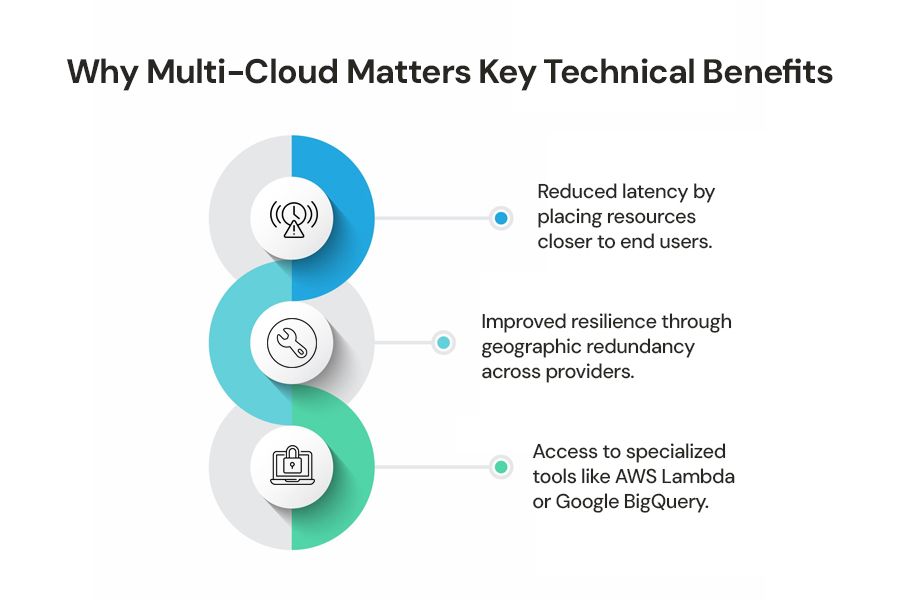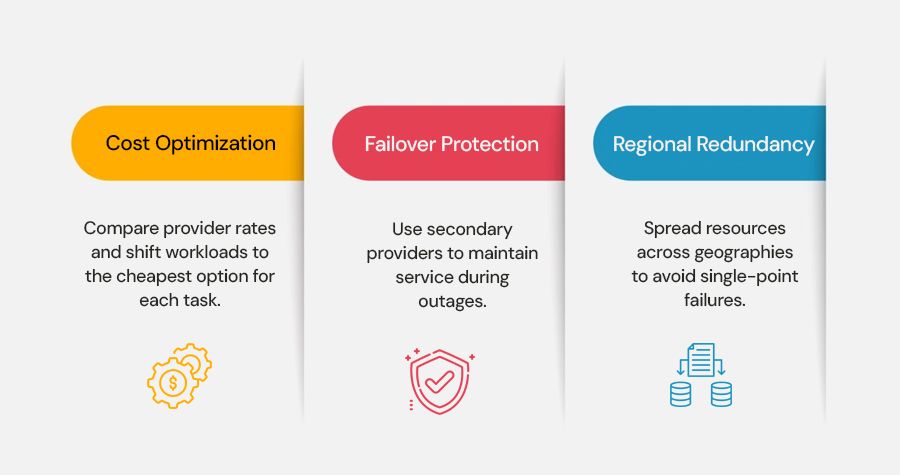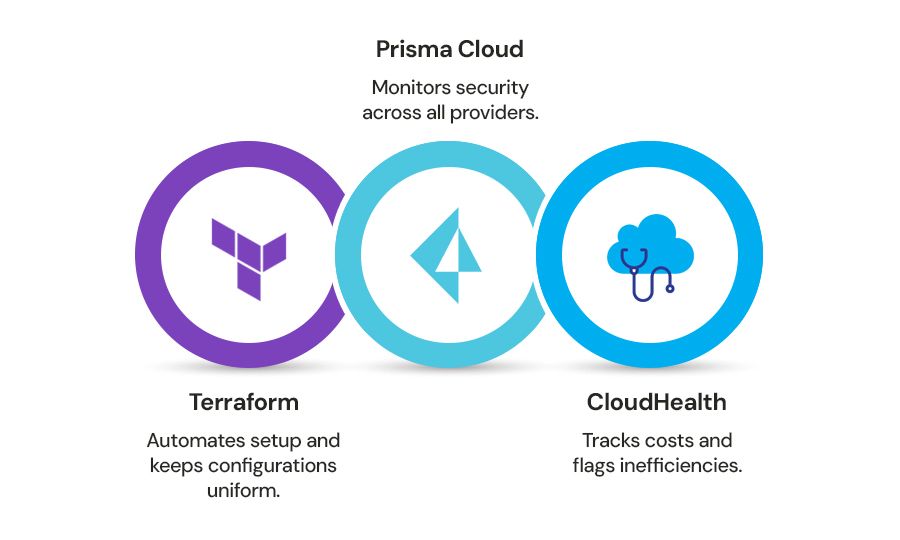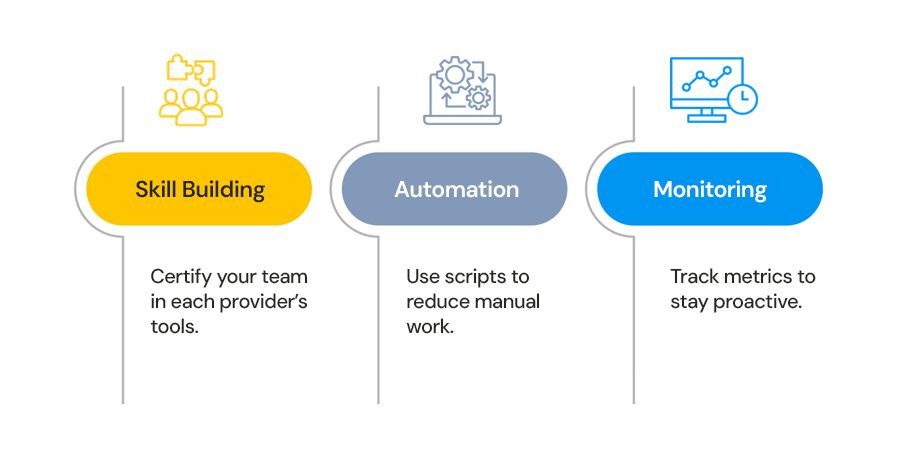
In today’s digital landscape, businesses rely heavily on cloud computing to power their operations, from hosting applications to storing vast amounts of data. Many organisations, however, find themselves tethered to a single cloud services provider, a situation that can lead to unexpected challenges. A sudden price increase, a regional server outage, or the discontinuation of a vital tool can disrupt workflows and force tough decisions: accept the new costs, weather the downtime, or undertake a costly migration. This dependency, known as vendor lock-in, poses a real risk to operational stability and financial predictability.
A multi-cloud strategy offers a practical solution. By distributing workloads across multiple cloud computing services providers, companies can reduce reliance on any one platform, gain greater control over their infrastructure, and optimise costs. This approach allows businesses to pick and choose services that best fit specific needs, improving performance and resilience. Far from a passing fad, multi-cloud represents a deliberate shift in how organisations approach cloud technology, offering a way to stay agile in a competitive environment.
This guide dives into the mechanics of vendor lock-in, the technical benefits of multi-cloud setups, and a clear, actionable plan for implementation. Aimed at IT leaders, system architects, and business decision-makers, it provides a detailed path to mastering multi-cloud environments while aligning with organisational priorities.
What Is Vendor Lock-In? A Closer Look
Vendor lock-in occurs when a business becomes so deeply integrated with a single cloud services provider that switching to another feels nearly impossible. It’s a gradual process. You start using their proprietary tools, build applications around their frameworks, and store data in formats designed for their systems. Over months or years, moving away becomes a daunting task—both technically and financially.
The consequences are significant. When a provider knows you’re committed, they hold the upper hand on pricing. A rate hike can strain budgets with little room to negotiate. Migration, meanwhile, turns into a complex ordeal: transferring databases, rewriting code, and retraining teams eat up time and resources. Worse still, a single point of failure emerges. If that provider’s infrastructure goes down—as seen in past outages from major players like AWS—your entire operation could stall. While platforms like Microsoft Azure or Google Cloud deliver reliable services, putting all your trust in one increases risk unnecessarily.
Multi-Cloud Explained: Structure and Goals
A multi-cloud strategy means using services from more than one cloud computing services provider instead of sticking to a single ecosystem. For example, a company might run its website on AWS, manage its customer database on Azure, and process analytics on Google Cloud. This isn’t the same as a hybrid cloud, which mixes private on-site systems with public cloud resources. Multi-cloud focuses solely on coordinating multiple public cloud platforms.
The reasoning is straightforward. Each provider has unique strengths: AWS scales compute power efficiently, Azure integrates smoothly with Microsoft tools, and Google Cloud excels at data-heavy tasks like machine learning. By spreading workloads across providers, you match tasks to the best platform, boosting performance. Multi-cloud also strengthens disaster recovery—if one provider’s servers fail, another can pick up the slack. Plus, it opens the door to cost savings by shifting workloads to the most affordable option for each job.
Why Multi-Cloud Matters: Key Technical Benefits

Breaking free from vendor lock-in is a major draw. When your systems span multiple cloud services providers, no single company controls your fate. If one raises prices or changes terms, you can adjust by moving resources elsewhere without a complete overhaul. This flexibility keeps costs manageable and preserves your ability to adapt.
Performance improves too. Providers operate data centers in different regions, so you can place workloads closer to your users—say, hosting a European app on a server with fast local access. This cuts latency and speeds up response times. It also builds resilience: a failure in one provider’s Midwest hub won’t sink you if another’s coastal servers are ready to step in.
Innovation becomes more accessible as well. Competition drives providers to roll out specialized tools. AWS offers serverless options like Lambda, Azure provides business intelligence through Power BI, and Google Cloud’s BigQuery tackles large-scale data analysis. With multi-cloud, you can use these strengths without being tied to one provider’s ecosystem.
Cost Savings and Resilience: A Deeper Dive
Managing expenses is a big motivator for adopting a multi-cloud approach. Pricing differs across platforms—Google Cloud might offer cheaper storage, while AWS beats on compute costs. By studying your needs and aligning workloads with the best rates, you can trim your cloud spending. Tools like cost calculators or third-party trackers simplify this process.
Resilience is just as critical. A single provider’s outage—like the AWS disruption in 2021—can halt operations, costing revenue and credibility. Multi-cloud counters this with redundancy. For instance, an online retailer could run its main site on Azure and keep a backup on Google Cloud, ready to take over if needed. This setup protects uptime and keeps customers happy.
Here’s how multi-cloud delivers on cost and resilience:

The Challenges of Going Multi-Cloud
Multi-cloud isn’t without hurdles. Managing multiple cloud computing services providers means dealing with different interfaces, security setups, and billing systems. Without a unified approach, you might end up with inconsistent configurations or isolated teams struggling to coordinate.
Security adds another layer of difficulty. Each provider has its own rules—AWS’s identity tools differ from Azure’s, for example. Gaps in alignment can expose weaknesses, like an overlooked setting on one platform compromising data on another. Costs can also spiral if you don’t watch for overlap or unused resources across providers.
Solving Multi-Cloud Pain Points
To handle complexity, consider cloud management platforms (CMPs) built for multi-cloud. Tools like VMware vRealize or HashiCorp Terraform offer a single dashboard to oversee deployments and track performance across providers. They smooth out differences, making administration easier and less error-prone.
Security demands a consistent framework. Set clear policies—covering access, encryption, and compliance—and apply them everywhere. Tools like Prisma Cloud or CloudGuard scan for issues and enforce standards automatically. Regular testing, like simulated attacks, keeps your defenses sharp.
For cost control, use tracking software like CloudHealth or CloudCheckr to monitor spending across platforms. These highlight waste—like forgotten test servers—and help you adjust. Schedule reviews every few months to fine-tune your setup.
Here are three tools to simplify multi-cloud:

Crafting Your Multi-Cloud Plan: A Step-by-Step Approach
First, evaluate your needs. Does the risk of lock-in outweigh the ease of a single provider? Do you need specific tools from different platforms? If the answer leans toward flexibility, multi-cloud makes sense.
Next, pick providers based on what they offer. AWS scales well and provides AI options like SageMaker. Azure fits companies using Microsoft products, linking easily with tools like Office 365. Google Cloud shines for data tasks with BigQuery. Don’t overlook smaller players—DigitalOcean can handle simpler jobs at lower rates.
Automation is essential. Managing multiple platforms manually invites mistakes. Kubernetes can run containerized apps across providers, while Ansible handles setup tasks. These tools save time and keep things consistent.
Preparing Your Team and Processes
Your staff needs to keep up. Each provider’s systems vary—AWS’s compute options aren’t identical to Azure’s. Training, like AWS or Azure certifications, builds the know-how to manage them. Hands-on practice solidifies those skills.
Monitoring can’t stop. Cloud setups change—usage spikes, costs shift, performance dips. Tools like Datadog or New Relic give you a clear view across providers, letting you adjust as needed. This ongoing tweak keeps your strategy on track.
Here’s what to focus on for people and processes:

Multi-Cloud in Action: Real Examples
Netflix runs its streaming service mostly on AWS but uses other providers for backup and data tasks, keeping viewers online during surges. Spotify pairs Google Cloud’s analytics with AWS’s infrastructure, balancing cost and speed. Airbnb splits workloads between AWS and Google Cloud, using regional strengths to serve users worldwide. These examples show how spreading resources across cloud services providers boosts reliability and efficiency.
Should You Go Multi-Cloud?
Multi-cloud isn’t for everyone. If a single provider meets your needs and lock-in isn’t a concern, the extra effort might not pay off. But if you value control, cost savings, or uptime, it’s worth exploring. Start small—move a low-stakes workload, test the setup, and grow from there.
Sticking to one cloud computing services provider can limit the freedom cloud technology promises. Multi-cloud flips that, blending strengths from multiple platforms into a robust, cost-smart system. Assess your goals, choose providers wisely, and use tools to keep it manageable. The payoff is an IT strategy ready for whatever comes next.
